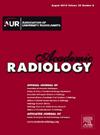Differentiation of Postoperative Tumor Recurrence and Pseudoprogression in Gliomas: A Comparative Study of Six Diffusion Models
IF 3.9
2区 医学
Q1 RADIOLOGY, NUCLEAR MEDICINE & MEDICAL IMAGING
引用次数: 0
Abstract
Rationale and Objectives
The purpose of this study is to investigate whether six diffusion models derived from multi-b-value diffusion-weighted imaging can enhance the differentiation between pseudoprogression (PsP) and postoperative tumor recurrence (TR) in glioma patients, with the aim of providing clinical insights.
Materials and Methods
A retrospective study was conducted on 82 patients with WHO grade 2–4 gliomas who underwent surgery at our hospital, with MRI sequences including T1WI, T2WI, T2FLAIR, contrast-enhanced T1WI, and multi-b-value DWI. Postoperative follow-up or secondary surgery pathology confirmed 46 cases of TR and 36 cases of PsP. Six diffusion models were fitted based on multi-b-value DWI sequences, including monoexponential DWI (Mono_DWI), intravoxel incoherent motion (IVIM), diffusion kurtosis imaging (DKI), stretched-exponential model (SEM), fractional-order calculus (FROC), and continuous-time random-walk (CTRW) model. ROIs were manually outlined to calculate the average values of each parameter. Differences between the two groups were compared using T-tests or Mann–Whitney U tests. The diagnostic performance of individual parameters was analyzed using ROC curve analysis, and the diagnostic performance of each model was compared using multivariate logistic regression.
Results
Among the 14 parameter maps, significant differences were found in all models (P<0.0036) except for IVIM_D*, IVIM_f. ROC curve analysis showed that CTRW_D demonstrated the highest AUC of 0.8484 (0.7549–0.9240). Further analysis of the diffusion models showed that CTRW performed the best among all models, with an AUC of 0.8635 (0.7816–0.9454), slightly higher than the FROC model, which had an AUC of 0.8629 (0.7839–0.9420).
Conclusion
The various diffusion models derived from multi-b-value DWI sequences can effectively distinguish between postoperative recurrence and pseudoprogression in gliomas. Among these models, the CTRW and FROC models are the two optimal models, demonstrating comparable diagnostic performance.
胶质瘤术后肿瘤复发与假性进展的鉴别:六种扩散模型的比较研究。
理由与目的:本研究的目的是探讨由多b值弥散加权成像衍生的六种弥散模型是否可以增强胶质瘤患者假进展(PsP)和术后肿瘤复发(TR)的鉴别,以期提供临床见解。材料与方法:回顾性研究82例在我院行手术的WHO 2-4级胶质瘤患者的MRI序列,包括T1WI、T2WI、T2FLAIR、增强T1WI、多b值DWI。术后随访或二次手术病理证实46例TR, 36例PsP。基于多b值DWI序列拟合了6种扩散模型,包括单指数DWI (Mono_DWI)、体内非相干运动(IVIM)、扩散峰态成像(DKI)、拉伸指数模型(SEM)、分数阶微积分(FROC)和连续时间随机漫步(CTRW)模型。人工勾画roi来计算每个参数的平均值。使用t检验或Mann-Whitney U检验比较两组之间的差异。采用ROC曲线分析各参数的诊断效能,采用多元logistic回归比较各模型的诊断效能。结果:在14个参数图中,所有模型均存在显著差异(p)。结论:多b值DWI序列衍生的各种扩散模型可有效区分胶质瘤术后复发和假性进展。在这些模型中,CTRW和FROC模型是两个最优模型,表现出相当的诊断性能。
本文章由计算机程序翻译,如有差异,请以英文原文为准。
求助全文
约1分钟内获得全文
求助全文
来源期刊

Academic Radiology
医学-核医学
CiteScore
7.60
自引率
10.40%
发文量
432
审稿时长
18 days
期刊介绍:
Academic Radiology publishes original reports of clinical and laboratory investigations in diagnostic imaging, the diagnostic use of radioactive isotopes, computed tomography, positron emission tomography, magnetic resonance imaging, ultrasound, digital subtraction angiography, image-guided interventions and related techniques. It also includes brief technical reports describing original observations, techniques, and instrumental developments; state-of-the-art reports on clinical issues, new technology and other topics of current medical importance; meta-analyses; scientific studies and opinions on radiologic education; and letters to the Editor.
 求助内容:
求助内容: 应助结果提醒方式:
应助结果提醒方式:


